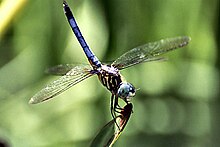Obelisk position

The obelisk position is a handstand-like position that some dragonflies (Odonata) adopt to prevent overheating on sunny days. The abdomen (abdomen) is then aimed directly at the sun, and so the heat radiation minimizes exposed body surface. When the sun is at its zenith , the vertical alignment of the dragonfly is reminiscent of an obelisk .
Occurrence and function

The obelisk position was observed in over 30 species from the families of the dragonflies (Calopterygidae), river maidens (Gomphidae) and especially the sail dragonflies (Libellulidae). All are predators who lie in wait for prey from their raised hide. The thermoregulation achieved by the obelisk position enables you to stay longer in the position despite the heat.
Under laboratory conditions, by illuminating with a 250 watt lamp, the obelisk position can also be created experimentally. Pachydiplax longipennis lifts the abdomen at high temperatures and lowers it again when it is shaded. It could be shown that behavior is an effective measure to prevent or slow down the rise in body temperature.
Dragonflies can also raise their abdomen for other reasons. Males of the aforementioned species also assume the obelisk position when they guard their territory and present the blue wax tires of the abdomen as advantageously as possible to impress other males.
Other forms of physical thermoregulation

Some dragonflies, for example Hagenius brevistylus, reduce the heat radiation by pointing their abdomen downwards, away from the sun. The tropical sailing dragonfly Diastatops intensa , whose wings are predominantly black, points its wings towards the sun instead of its abdomen, apparently in order to reduce exposure to the radiation that it absorbs.
Some representatives of the genus Tramea lower their abdomen during flight into the shadow area, which is caused by dark areas on the wing base of the hind wings. Pseudothemis zonata shows the same behavior with a similar wing meal.
The position to the sun can also be used to increase the body temperature. Keeping the flight muscles in the thorax warm is particularly important for dragonflies, as otherwise they would not be able to fly. Some can position their wings in such a way that they reflect solar radiation onto their own body or with the wings they can form a kind of greenhouse over the thorax, which absorbs the heat from the ground. When the sun is low, dragonflies align their abdomen perpendicular to the radiation to maximize the surface area exposed to direct sunlight. If this behavior is also similar to the obelisk position, it serves the opposite purpose.
swell
literature
- Phillip S. Corbet: Dragonflies: Behavior and Ecology of Odonata. Cornell University Press, Ithaca, NY 1999, ISBN 0-8014-2592-1 , pp. 285-287.
- Bernd Heinrich: The Thermal Warriors: Strategies of Insect Survival. Harvard University Press, Cambridge 1999, ISBN 0-674-88341-1 , pp. 66-67.
- Michael L. May: Thermoregulation and Adaptation to Temperature in Dragonflies (Odonata: Anisoptera). Ecological Monographs 46 (1) 1976, pp. 1-32.
- Clifford Johnson: A Study of Territoriality and Breeding Behavior in Pachydiplax longipennis Burmeister (Odonata: Libellulidae). The Southwestern Naturalist 7 (3/4) 1962, pp. 191-197.
Individual evidence
- ↑ a b c d Phillip S. Corbet: Dragonflies: Behavior and Ecology of Odonata. , Pp. 285-287
- ↑ a b Michael L. May: Thermoregulation and Adaptation to Temperature in Dragonflies. , Pp. 1-32
- ^ Clifford Johnson: A Study of Territoriality and Breeding Behavior in Pachydiplax longipennis Burmeister. , Pp. 191-197